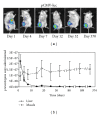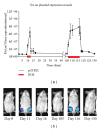Control and augmentation of long-term plasmid transgene expression in vivo in murine muscle tissue and ex vivo in patient mesenchymal tissue
- PMID: 22811595
- PMCID: PMC3395381
- DOI: 10.1155/2012/379845
Control and augmentation of long-term plasmid transgene expression in vivo in murine muscle tissue and ex vivo in patient mesenchymal tissue
Abstract
Purpose: In vivo gene therapy directed at tissues of mesenchymal origin could potentially augment healing. We aimed to assess the duration and magnitude of transene expression in vivo in mice and ex vivo in human tissues.
Methods: Using bioluminescence imaging, plasmid and adenoviral vector-based transgene expression in murine quadriceps in vivo was examined. Temporal control was assessed using a doxycycline-inducible system. An ex vivo model was developed and optimised using murine tissue, and applied in ex vivo human tissue.
Results: In vivo plasmid-based transgene expression did not silence in murine muscle, unlike in liver. Although maximum luciferase expression was higher in muscle with adenoviral delivery compared with plasmid, expression reduced over time. The inducible promoter cassette successfully regulated gene expression with maximum levels a factor of 11 greater than baseline. Expression was re-induced to a similar level on a temporal basis. Luciferase expression was readily detected ex vivo in human muscle and tendon.
Conclusions: Plasmid constructs resulted in long-term in vivo gene expression in skeletal muscle, in a controllable fashion utilising an inducible promoter in combination with oral agents. Successful plasmid gene transfection in human ex vivo mesenchymal tissue was demonstrated for the first time.
Figures






Similar articles
-
Sustained, high transgene expression in liver with plasmid vectors using optimized promoter-enhancer combinations.J Gene Med. 2011 Jul;13(7-8):382-91. doi: 10.1002/jgm.1585. J Gene Med. 2011. PMID: 21721074
-
Adenoviral-mediated gene transfer into ex vivo expanded human bone marrow mesenchymal progenitor cells.Exp Hematol. 2000 Apr;28(4):382-90. doi: 10.1016/s0301-472x(00)00134-x. Exp Hematol. 2000. PMID: 10781896
-
Evaluation of Tet-on system to avoid transgene down-regulation in ex vivo gene transfer to the CNS.Gene Ther. 2002 Oct;9(19):1291-301. doi: 10.1038/sj.gt.3301778. Gene Ther. 2002. PMID: 12224012
-
Advances in plasmid gene delivery and expression in skeletal muscle.Curr Opin Mol Ther. 2000 Apr;2(2):150-4. Curr Opin Mol Ther. 2000. PMID: 11249635 Review.
-
CORP: Gene delivery into murine skeletal muscle using in vivo electroporation.J Appl Physiol (1985). 2022 Jul 1;133(1):41-59. doi: 10.1152/japplphysiol.00088.2022. Epub 2022 May 5. J Appl Physiol (1985). 2022. PMID: 35511722 Free PMC article. Review.
Cited by
-
Stem cell attraction via SDF-1α expressing fat tissue grafts.J Biomed Mater Res A. 2013 Jul;101(7):2067-74. doi: 10.1002/jbm.a.34512. Epub 2012 Dec 22. J Biomed Mater Res A. 2013. PMID: 23281045 Free PMC article.
-
Advances and challenges in gene therapy strategies for pediatric cancer: a comprehensive update.Front Mol Biosci. 2024 May 21;11:1382190. doi: 10.3389/fmolb.2024.1382190. eCollection 2024. Front Mol Biosci. 2024. PMID: 38836106 Free PMC article. Review.
-
The Effect of Repeat Administration of Lipoplexes on Gene Delivery, Biodistribution, and Cytokine Response in Immunocompetent Tumor-Bearing Mice.J Pharm Sci. 2022 Jul;111(7):1926-1936. doi: 10.1016/j.xphs.2021.12.017. Epub 2021 Dec 18. J Pharm Sci. 2022. PMID: 34929156 Free PMC article.
References
-
- Evans CH. Orthopaedics: gene therapy’s dark horse. Gene Therapy. 2004;11(4):p. 343. - PubMed
-
- Hannallah D, Peterson B, Lieberman JR, Fu FH, Huard J. Gene therapy in orthopaedic surgery. Instructional Course Lectures. 2003;52:753–768. - PubMed
-
- Hildebrand K, Frank C. Ligaments: structure, function and response to injury and repairin. In: Dee R, et al., editors. Principles of Orthopaedic Practice. New York, NY, USA: McGraw-Hill; 1997. pp. 109–117.
-
- Kloen P, Di Paola M, Borens O, et al. BMP signaling components are expressed in human fracture callus. Bone. 2003;33(3):362–371. - PubMed
-
- Bolt P, Clerk AN, Luu HH, et al. BMP-14 gene therapy increases tendon tensile strength in a rat model of achilles tendon injury. Journal of Bone and Joint Surgery—Series A. 2007;89(6):1315–1320. - PubMed
Publication types
MeSH terms
Substances
LinkOut - more resources
Full Text Sources

